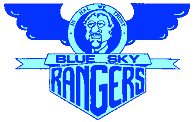OTHER UNRELEASED 2600 TITLES
Anteater
ATARI 2600 CARTRIDGE [UNRELEASED]
Based on the Stern arcade game
Program: Stephen Tatsumi
Graphics: Joe [Ferreira] King
Sound Effects/Music: Patricia Lewis Du Long
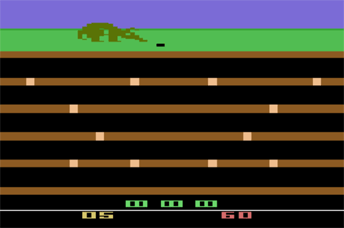
DEVELOPMENT HISTORY
This conversion of the Stern arcade game was essentially completed in 1983, but its release was cancelled for unknown reasons before it could go through the Quality Assurance process.

Blow Out
ATARI 2600 CARTRIDGE [UNFINISHED, #MA89]
Program: David Akers
GAME DESCRIPTION
A game designed to be played at parties by two teams. Two players - one member from each team - go head to head controlling Disco roller skaters dropping darts onto rising balloons. They pop as many balloons as possible before - BEEP! - they have to hand the joysticks to the next members of their teams. Fast and colorful with bouncy original music - it's the perfect party game!
DEVELOPMENT HISTORY
Blow Out was to be an Atari version of the Blow Out game in the Intellivision Party Line album cartridge. While the game was assigned an in-house bookkeeping number, it never received the four-digit product number that made a project "official." David Akers only worked on the game briefly in June 1983 before being pulled off to work on higher priority projects. The game remained designated "On Hold" when Mattel Electronics closed.
Cumulus
ATARI 2600 CARTRIDGE [UNFINISHED]
Program: Jeff Ratcliff
GAME DESCRIPTION
You must protect the cloud city of Cumulus from descending enemy ships. Your first line of defense are battle pods that float above the city. If the ships manage to destroy your pods, you must fight the enemy on the planet surface where they will attack the generators that project a protective energy shield around the city. Should the generators be destroyed, the city is doomed!
DEVELOPMENT HISTORY
Cumulus was an original Atari 2600 idea by Jeff Ratcliff. His idea was to take a relatively simple game but use the extra memory available on a Super Cartridge to create spectacular visual effects not seen before on Atari - mainly really cool explosions. He worked on the game briefly in August 1983, programming a demonstration screen showing a high-resolution cloud with an enemy ship above it. While the game was listed on the weekly in-house status reports, it never received the four-digit product number that made a project "official." Jeff was pulled off of the game to work instead on the Atari version of Masters of the Universe II.
Cumulus was still designated "Low Priority" when Mattel Electronics closed.
Dual Scrolling
ATARI 2600 CARTRIDGE [UNFINISHED, #7848]
Design/Program: David Akers
GAME DESCRIPTION
None.
DEVELOPMENT HISTORY
Late in 1983, David Akers came up with an interesting effect on the Atari 2600 - he demonstrated that the screen could be split in two with each half scrolling a background - such as a maze - independently of the other. He didn't have any game in mind when showing this, but Marketing loved the effect - it was like nothing else seen before on Atari and they believed they could promote it.
After determining the same effect could be created on Intellivision, Marketing put the still-to-be-determined game - temporarily called Dual Scrolling - onto the official release schedule. That was December 19, 1983. Exactly one month later, Mattel Electronics closed. Although no game concept had yet been thought of, Dual Scrolling was one of the few games officially still in development for the Atari 2600 when the doors were shut.
Flapper
ATARI 2600 CARTRIDGE [UNFINISHED]
AKA Beanie Bopper, Jumper
Program: Stephen Tatsumi
GAME DESCRIPTION (from programmer's proposal)
You control the Flapper to rescue baby Flappers from an underground maze. The maze is filled with snakes, bats and ghosts. Cave-ins and landslides keep opening and closing the tunnels. Luckily, the Flapper is a unique fellow: he has three types of beanies - chopper for flying, gun for shooting, umbrella for protection - and four interchangeable types of legs: flying, jumping, running and walking. You have to find and change the appropriate beanie and legs for him to overcome the obstacles and rescue the babies!
DEVELOPMENT HISTORY
Flapper was an original Atari 2600 idea by Steve Tatsumi. While the game was listed on the weekly in- house status reports, it never received the four-digit product number that made a project "official." Steve worked on Flapper briefly in August 1983 before being pulled off to work on higher priority projects.
Flapper was still designated "Low Priority" when Mattel Electronics closed.
Flashlight
ATARI 2600 CARTRIDGE [UNFINISHED, #7847]
Program: Ron Surratt
GAME DESCRIPTION
None.
DEVELOPMENT HISTORY
In 1983, Stephen Roney came up with an interesting spotlight effect on the Intellivision: a moving circle of "light" could move around an otherwise black screen, "illuminating" the background and moving objects within the circle. Although he didn't have any game in mind, Marketing loved the effect. It was different enough for them to promote as a "graphics breakthrough."
Ron Surratt was asked to duplicate the effect on the Atari 2600. Once he showed it could work on that platform, Marketing put the still-to-be-determined game onto the schedule for release on Intellivision, Atari, PC Jr. and Colecovision. This was November 1983. When Mattel Electronics closed two months later, no one had yet come up with a game for Flashlight, but it was still officially in development.
Hydroplane
ATARI 2600 CARTRIDGE [UNFINISHED, #7849]
Program: Stephen Tatsumi
GAME DESCRIPTION
A high-speed pilot's-point-of-view speedboat race.
DEVELOPMENT HISTORY
Hydroplane was the Atari version of the Intellivision Hydroplane cartridge then in development, late 1983. The game was still officially in development when Mattel Electronics closed in January 1984.
FUN FACT: Despite the fact that Steve Tatsumi was listed on the official Project Status Report as the programmer for Atari Hydroplane, Steve doesn't recall ever working on the game. As fast as things were changing in the final days of Mattel Electronics, it may well be that Steve was never actually told he was scheduled to be the project's programmer.
Loco-Motion
ATARI 2600 CARTRIDGE [UNRELEASED]
Based on the Konami, Inc. arcade game
Program: Jeff Ratcliff
Sound Effects/Music: Patricia Lewis Du Long
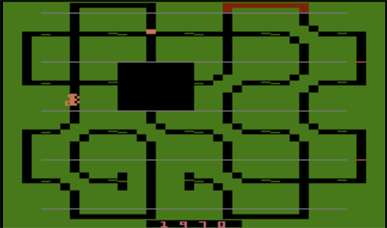
DEVELOPMENT HISTORY
Loco-Motion was the Atari version of the Konami arcade game, previously released for Intellivision. Although a working version of the game was finished and in the Quality Assurance process, the cartridge was cancelled July 5, 1983 for unknown reasons.

Masters of the Universe II
ATARI 2600 CARTRIDGE [UNFINISHED, #7846]
Program: Jeff Ratcliff
Graphics: Connie Goldman
GAME DESCRIPTION
The further adventures of He-Man and his battles against Skeletor.
DEVELOPMENT HISTORY
In December 1983, Jeff Ratcliff was assigned to Masters of the Universe II. Ray Kaestner had created an interesting 3-D moving maze for part of the game on Intellivision. Jeff and graphics artist Connie Goldman worked on translating the effect onto the Atari 2600. At that point, no real gameplay had been defined, but when Mattel Electronics closed a month later this title was still officially in production.
Mission X
ATARI 2600 CARTRIDGE [UNFINISHED]
Based on the Data East USA arcade game
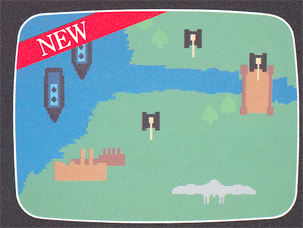
DEVELOPMENT HISTORY
Mission X was the Atari version of the Data East USA arcade game, previously released for Intellivision. Despite being listed in Mattel Electronics catalogs and press releases during 1983, the cartridge was cancelled for unknown reasons.
Monkey Business
ATARI 2600 CARTRIDGE [UNFINISHED]
Program: Eric Del Sesto
GAME DESCRIPTION (from programmer's proposal)
In the zoo, things have gone awry. Billy the Chimp has escaped and is up to no good. As any curious monkey would, he has managed to free the elephants! It's up to you, as Mike the Zookeeper, to return the elephants to their cages.
Once you have restored order in the elephant section, you must quickly run to the next section of cages. Perhaps you'll have to capture the loose Koalas. Maybe you'll have to avoid soaring hawks, battle fierce tigers or try to grab the slippery penguins. Along the way, you'll find items which will be of help to you, such as a bag of peanuts or a net. So grab your hat and stop this monkey business!
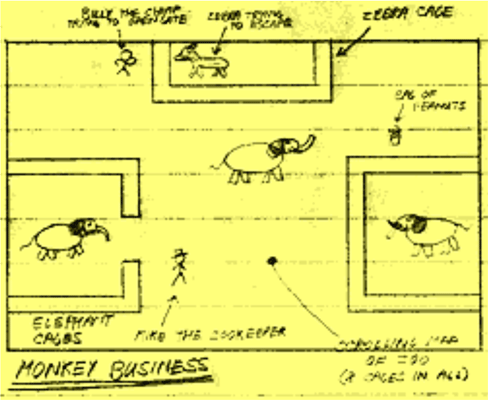
DEVELOPMENT HISTORY
Eric Del Sesto, the last Mattel Electronics programmer hired, worked on this original game idea as his training project mid-1983. The game featured a seven-page scrolling map of the zoo with a new graphics technique called "hidden V-clocks" which produced wider, cleaner displays.
In August, when the game was about half completed, Eric wrote it up as a formal proposal for an M Network release. Instead, he was asked to help get the bug-ridden Apple version of BurgerTime completed. After BurgerTime, he went to work on Colecovision Masters of the Universe II. Monkey Business was left unfinished.
The drawing is by Eric from his proposal for the game.


Sharp Shot
ATARI 2600 CARTRIDGE [UNRELEASED]
Produced bu APh Technology Consultants for Mattel Electronics
Program: Jeff Ronne
GAME DESCRIPTION (INTELLIVISION version, January 1983 Consumer Electronics Show)
An exciting new target shooting game specially designed for children. There are four different shooting ranges for one or two players. Hit the pass receiver. Shoot down the spinning spacecraft. Bomb Navy ships. Fire at the maze monsters. Challenging action for video game beginners.
DEVELOPMENT HISTORY
Mattel decided not to release this Atari version of the Intellivision Sharp Shot cartridge, which was programmed at APh Technology Consulting on spec.
